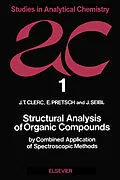Structural Analysis of Organic Compounds covers some practical analytical aspects of organic structural analysis by combined application of spectroscopic methods.
This book is composed of three parts encompassing 35 chapters that specifically describe infrared-, ultraviolet-, proton and carbon-13 nuclear magnetic resonance and mass spectroscopy. Considerable chapters discuss the problems intended to cover a wide variety of chemical structure and spectroscopic argument, thereby exemplifying interpretations and comment on specific practical aspects of the problem solving procedure. The remaining chapters provide short supplementing research concerning various aspects of structural analysis.
This book will prove useful to organic and analytical chemists.
Inhalt
Preface
Part 1 Initial Remarks
Presentation of Data
Mass Spectra
Infrared Spectra
Proton NMR Spectra
Carbon-13 NMR Spectra
Ultraviolet Spectra
Assisting Measures
Mass Spectroscopy
Infrared Spectroscopy
Proton NMR Spectroscopy
Carbon-13 NMR Spectroscopy
Ultraviolet Spectroscopy
Reference Data
Combined Tables for All Methods Used in this Context
Mass Spectroscopy
Infrared Spectroscopy
Proton NMR Spectroscopy
Carbon-13 NMR Spectroscopy
Ultraviolet Spectroscopy
Technical Terms
Isochronous Nuclei
Magnetic Equivalence
Nomenclature of Spin Systems
Working Philosophy
Part 2 Problems
Problem 1
Elemental Composition and Structural Features
Structural Assembly
Comments
Problem 2
Elemental Composition and Structural Features
Structural Assembly
Comments
Problem 3
Elemental Composition and Structural Features
Structural Assembly
Comments
Problem 4
Elemental Composition and Structural Features
Structural Assembly
Comments
Problem 5
Elemental Composition and Structural Features
Structural Assembly
Comments
Problem 6
Elemental Composition and Structural Features
Structural Assembly
Comments
Problem 7
Elemental Composition and Structural Features
Structural Assembly
Comments
Problem 8
Elemental Composition and Structural Features
Structural Assembly
Comments
Problem 9
Elemental Composition and Structural Features
Structural Assembly
Comments
Problem 10
Elemental Composition and Structural Features
Structural Assembly
Comments
Problem 11
Elemental Composition and Structural Features
Structural Assembly
Comments
Problem 12
Elemental Composition and Structural Features
Structural Assembly
Comments
Problem 13
Elemental Composition and Structural Features
Structural Assembly
Comments
Problem 14
Elemental Composition and Structural Features
Structural Assembly
Comments
Problem 15
Elemental Composition and Structural Features
Structural Assembly
Comments
Problem 16
Elemental Composition and Structural Features
Structural Assembly
Comments
Problem 17
Elemental Composition and Structural Features
Structural Assembly
Comments
Problem 18
Elemental Composition and Structural Features
Structural Assembly
Comments
Problem 19
Elemental Composition and Structural Features
Structural Assembly
Comments
Problem 20
Elemental Composition and Structural Features
Structural Assembly
Comments
Problem 21
Elemental Composition and Structural Features
Structural Assembly
Comments
Problem 22
Elemental Composition and Structural Features
Structural Assembly
Comments
Problem 23
Elemental Composition and Structural Features
Structural Assembly
Comments
Problem 24
Elemental Composition and Structural Features
Structural Assembly
Comments
Problem 25
Elemental Composition and Structural Features
Structural Assembly
Comments
Problem 26
Elemental Composition and Structural Features
Structural Assembly
Comments
Problem 27
Elemental Composition and Structural Features
Structural Assembly
Comments
Problem 28
Elemental Composition and Structural Features
Structural Assembly
Comments
Problem 29
Elemental Composition and Structural Features
Structural Assembly
Comments
Problem 30
Elemental Composition and Structural Features
Structural Assembly
Part 3 Short Supplementing Essays
Degree of Unsaturation. Calculation of Number of Double Bond Equivalents
General Information from Mass Spectra
Evidence for Elemental Composition from Isotope Peak Intensities
Evidence for Elemental Composition in Low Resolution Mass Spectra
High Resolution Data
Impurities in Mass Spectra
Prediction of Infrared Stretching Frequencies
Overtones, Combination Bands, Fermi Resonance
Band Shapes and Intensities in Infrared Spectra
Spurious Bands in Infrared Spectra
Rules for the Interpretation of Proton NMR Spectra
General Rules
Rules for First Order Spectra
Higher Order Spectra
Simplification of Higher Order Spectra
Computer Simulation of Spectra
Off-Resonance Decoupled Spectra
Signal Intensities in Carbon-13 NMR Spectra
Saturation
Nuclear Overhauser Effect
Other Influences
Intensities of Solvent Signals
Influence of Molecular Symmetry and Conformational Equilibria on NMR Spectra
Introduction
Influence of Symmetry Properties on the NMR Spectra
Fast Conformational Equilibria
Examples
Bulk Susceptibility Corrections
Solvents in Ultraviolet Spectroscopy
Interactions of Chromophores
Appendix
Isotope Distribution Pattern of All Natural Elements in the Periodic System
Mass Correlation Table
Mass Spectra of some Important Solvents which Occur Frequently as Impurity in Mass Spectra of Organic Samples
Infrared Absorption Spectra of some Common Solvents and Suspension Agents
Estimation of the Proton Chemical Shifts in Substituted Alkanes
Estimation of the Chemical Shifts of Olefinic Protons
Estimation of the Proton Chemical Shifts in Substituted Benzene
Estimation of the Carbon-13 Chemical Shifts in Aliphatic Compounds
Steric Corrections S
Conformational Corrections C
Estimation of the Chemical Shifts of Olefinic Carbon Atoms
Estimation of the Carbon-13 Chemical Shifts in Substituted Benzene
Estimation of the Carbon-13 Chemical Shifts in Substituted Pyridine
Subject Index
Structures of Compounds
